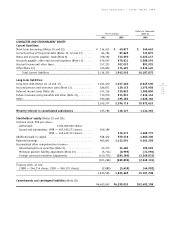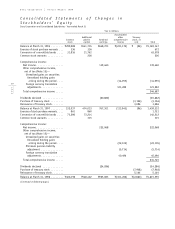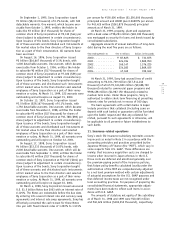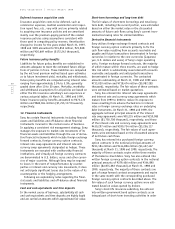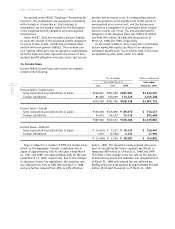Sony 1999 Annual Report Download - page 56
Download and view the complete annual report
Please find page 56 of the 1999 Sony annual report below. You can navigate through the pages in the report by either clicking on the pages listed below, or by using the keyword search tool below to find specific information within the annual report.
54
page
Sony Corporation Annual Report 1999
on the existing assets and liabilities. Such contracts
on anticipated transactions, including contracts used
to hedge intercompany foreign currency commit-
ments which do not qualify as firm commitments, are
marked to market with changes in value recognized
in foreign exchange gains/losses.
Foreign currency option contracts
Sony enters into purchased foreign currency option
contracts to limit exposure to losses, resulting from
changes in foreign currency exchange rates, on
accounts receivable and anticipated transactions
denominated in foreign currencies. Sony also enters
into written foreign currency option contracts, of
which the majority are part of range forward con-
tracts corresponding to the purchased foreign cur-
rency option contracts. The carrying values of all
foreign currency option contracts are marked to
market with changes in value recognized in foreign
exchange gains/losses.
Interest rate swap agreements and interest rate
and currency swap agreements
Sony enters into interest rate swap agreements or
interest rate and currency swap agreements in order
to lower funding costs, to diversify sources of fund-
ing and to limit Sony’s exposure to loss in relation to
underlying debt instruments resulting from adverse
fluctuations in interest rates or foreign currency
exchange rates. The related interest differentials paid
or received under the interest rate swap agreements
and under the interest rate and currency swap agree-
ments are recognized over the terms of the agree-
ments in interest expense. Currency swap portions
of the interest rate and currency swap agreements
which are designated and effective as hedges of
exposure to losses resulting from changes in foreign
currency exchange rates on underlying debt denomi-
nated in foreign currency are marked to market and
included as an offset to foreign exchange gains/
losses on the underlying debt.
After an underlying hedged transaction is settled
or ceases to exist, all changes in fair value of related
derivatives which have not been settled are recognized
in foreign exchange gains/losses.
Net income per share
Basic net income per share (EPS) is computed based on
the average number of shares of common stock out-
standing during each period and diluted EPS assumes
the dilution that could occur if securities or other
contracts to issue common stock were exercised or
converted into common stock or resulted in the issuance
of common stock. EPS is appropriately adjusted for any
free distributions of common stock.
Free distribution of common stock
On occasion, Sony Corporation may make a free distribu-
tion of common stock which is accounted for either by a
transfer of the applicable par value from additional paid-
in capital to the common stock account or with no entry
if free shares are distributed from the portion of previ-
ously issued shares accounted for as excess of par value
in the common stock account. Under the Japanese
Commercial Code, a stock dividend can be effected by
an appropriation of retained earnings to the common
stock account by resolution of the general stockholders’
meeting, followed by a free share distribution with
respect to the amount appropriated by resolution of
the Board of Directors’ Meeting.
Common stock issue costs
Common stock issue costs are directly charged to retained
earnings, net of tax, in the accompanying consolidated
financial statements as the Japanese Commercial Code
prohibits charging such stock issue costs to capital
accounts which is the prevailing practice in the United
States of America.
Comprehensive income
Sony adopted Statement of Financial Accounting
Standards (FAS) No. 130, ”Reporting Comprehensive
Income” in the quarter ended June 30, 1998. Compre-
hensive income is defined in this standard as total
change in stockholders’ equity excluding capital trans-
actions. Sony’s comprehensive income comprises net
income plus other comprehensive income representing
changes in foreign currency translation adjustments,
unrealized gains/losses on securities and minimum
pension liability adjustment. Sony has elected to dis-
close comprehensive income and its components in the
statement of changes in stockholders’ equity.
Recent pronouncements
Derivative instruments and hedging activities
In June 1998, the Financial Accounting Standards
Board issued FAS 133, “Accounting for Derivative
Instruments and Hedging Activities”. This standard,
which is effective for fiscal years beginning after
June 15, 1999, requires all derivatives to be recog-
nized in the statement of financial position as either
assets or liabilities and measured at fair value. To
implement this standard, all hedging relationships
must be reassessed. Sony is now in the process of
assessing the impact that this standard will have on
Sony’s results of operations and consolidated finan-
cial position.
Reclassifications
Certain reclassifications of the financial statements for
the years ended March 31, 1997 and 1998 have been
made to comform to the presentation for the year ended
March 31, 1999.





